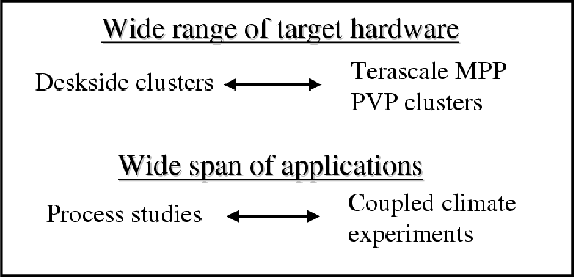|
|
|
|




Next: 4.2 WRAPPER
Up: 4. Software Architecture
Previous: 4. Software Architecture
Contents
Broadly, the goals of the software architecture employed in MITgcm are
three-fold
- We wish to be able to study a very broad range
of interesting and challenging rotating fluids problems.
- We wish the model code to be readily targeted to
a wide range of platforms
- On any given platform we would like to be
able to achieve performance comparable to an implementation
developed and specialized specifically for that platform.
These points are summarized in figure 4.1
which conveys the goals of the MITgcm design. The goals lead to
a software architecture which at the high-level can be viewed as consisting
of
- A core set of numerical and support code. This is discussed in detail in
section
![[*]](crossref.png) . .
- A scheme for supporting optional "pluggable" packages (containing
for example mixed-layer schemes, biogeochemical schemes, atmospheric physics).
These packages are used both to overlay alternate dynamics and to introduce
specialized physical content onto the core numerical code. An overview of
the package scheme is given at the start of part
![[*]](crossref.png) . .
- A support framework called WRAPPER (Wrappable Application Parallel
Programming Environment Resource), within which the core numerics and pluggable
packages operate.
This chapter focuses on describing the WRAPPER environment under which
both the core numerics and the pluggable packages function. The description
presented here is intended to be a detailed exposition and contains significant
background material, as well as advanced details on working with the WRAPPER.
The examples section of this manual (part ![[*]](crossref.png) ) contains more
succinct, step-by-step instructions on running basic numerical
experiments both sequentially and in parallel. For many projects simply
starting from an example code and adapting it to suit a particular situation
will be all that is required. ) contains more
succinct, step-by-step instructions on running basic numerical
experiments both sequentially and in parallel. For many projects simply
starting from an example code and adapting it to suit a particular situation
will be all that is required.
Figure 4.1:
The MITgcm architecture is designed to allow simulation of a wide
range of physical problems on a wide range of hardware. The computational
resource requirements of the applications targeted range from around
 bytes ( bytes (
 megabytes ) of memory to megabytes ) of memory to  bytes
( bytes
(
 gigabytes). Arithmetic operation counts for the applications of
interest range from gigabytes). Arithmetic operation counts for the applications of
interest range from  floating point operations to more than floating point operations to more than  floating point operations.
floating point operations.
|
|




Next: 4.2 WRAPPER
Up: 4. Software Architecture
Previous: 4. Software Architecture
Contents
mitgcm-support@dev.mitgcm.org
| Copyright © 2002
Massachusetts Institute of Technology |
 |
|









![[*]](crossref.png)



